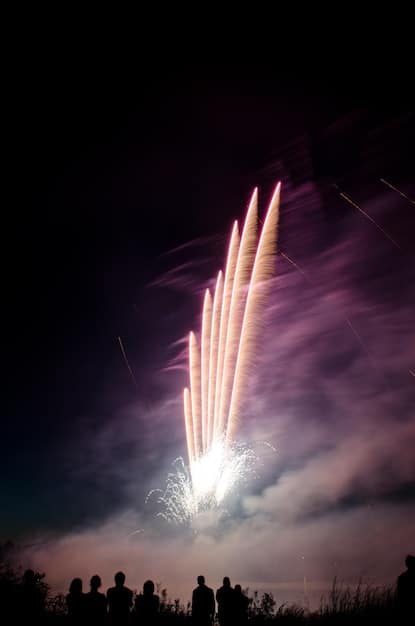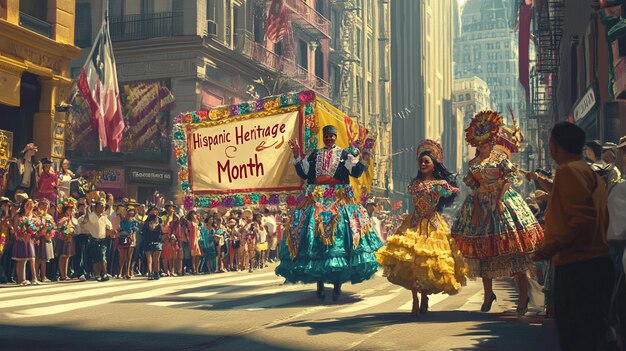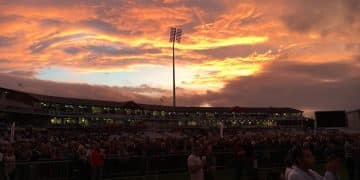World Cup 2026: What to Expect from the Opening Ceremony

The World Cup 2026 opening ceremony in North America is anticipated to be an unprecedented spectacle, blending technological innovation, cultural diversity, and global unity to kick off the expanded tournament across three host nations.
As the countdown to football’s grandest event begins, discussions are already swirling about the fanfare that will mark its commencement. The World Cup 2026 opening ceremony promises to be more than just a typical curtain-raiser; it’s set to define a new era for sports entertainment. This monumental occasion, spread across three host nations, carries the weight of immense expectations from fans globally.
The Trilateral Hosting Advantage and Its Ceremonial Impact
The 2026 FIFA World Cup signals a historic shift, hosted by an unprecedented trio of nations: the United States, Canada, and Mexico. This trilateral arrangement is not merely a logistical feat; it profoundly influences every aspect of the tournament, especially the opening ceremony. The sheer scale and ambition of this co-hosting model present both unique challenges and unparalleled opportunities for a spectacular inauguration.
Each host nation brings a rich cultural tapestry and a distinct footballing heritage to the table. The United States, with its prowess in large-scale event production, is expected to infuse technological innovation and entertainment spectacle. Canada offers a vibrant multiculturalism and a growing passion for the sport, while Mexico contributes its deep-rooted footballing traditions and passionate fan base. The ceremony is poised to be a powerful amalgamation of these diverse strengths.
Logistical Complexity and Creative Opportunity
Organizing an event of this magnitude across such vast geographical distances requires meticulous planning. The decision of where to host the main opening ceremony remains a critical point of speculation. Will it be a single, grand event in one iconic venue, or will there be simultaneous, smaller ceremonies across multiple cities, each offering a regional flavor?
- Single Grand Ceremony: Centralizing the event would allow for maximum impact and a unified global message, likely in a major U.S. city like New York or Los Angeles.
- Multi-City Approach: Distributing the ceremony across cities in all three nations could emphasize the trilateral partnership and engage a broader audience directly.
- Technological Synchronization: Regardless of the chosen format, advanced broadcasting and connectivity will be crucial to link narratives and experiences across borders.
The organizing committee faces the task of crafting a narrative that transcends national boundaries, celebrating the unity of sport while honoring the distinct identities of the host countries. This fusion could be expressed through artistic performances, musical collaborations, and visual storytelling that bridges the gaps between different cultures.
Considering the magnitude of this event, the logistical planning extends beyond the immediate ceremony. It encompasses coordinating security, transportation, and public engagement across diverse legal and administrative frameworks. The ability to seamlessly integrate these elements will be a testament to FIFA’s organizational capabilities and the collaborative spirit of the host nations.
Technological Integration: Beyond Pyrotechnics
Past World Cup opening ceremonies have showcased impressive pyrotechnics and elaborate stage designs, but the 2026 event is expected to push technological boundaries further. This goes beyond mere visual spectacle; it involves integrating advanced digital experiences to enhance global viewership and audience engagement inside the stadium.
Virtual and augmented reality (VR/AR) could play a significant role. Imagine viewers at home experiencing the ceremony through interactive VR streams, feeling as if they are on the field with the performers. Inside the stadium, AR overlays could transform the field into dynamic canvases, displaying real-time information or artistic projections that interact with live performances. Drone technology, already seen in recent events, could be elevated to create mesmerizing aerial ballets, forming complex patterns and illuminating the stadium sky.
Immersive Fan Experience Through Digital Innovation
- Interactive Projections: The stadium floor becoming an interactive screen, responding to performers and music.
- Drone Choreography: Hundreds, even thousands, of drones forming intricate shapes and images in the night sky.
- Real-time Data Visualization: Incorporating live statistics or historical data of the World Cup into visual displays, enhancing the narrative.
Beyond the visual, sound technology will be critical. Advanced spatial audio systems could create an immersive soundscape that envelops stadium audiences, making every beat and crescendo resonate powerfully. For home viewers, personalized audio experiences, perhaps allowing them to switch between different commentary teams or focus on specific sound elements, could revolutionize broadcast consumption.
The fusion of these technologies offers unprecedented opportunities for storytelling. The narrative of the World Cup, from its humble beginnings to its global phenomenon status, could be told through a combination of live performance and cutting-edge digital artistry. This approach ensures that the ceremony is not just a show, but a multi-sensory journey designed to captivate and inspire. It promises to be a digital landmark in sports broadcasting.
Cultural Showcase: A Symphony of Three Nations
The essence of the World Cup 2026 opening ceremony lies in its unique opportunity to celebrate the diverse cultures of the United States, Canada, and Mexico. This trilateral showcase demands a careful curation of artistic elements that honor each nation’s heritage while weaving a unified narrative of global football.
Mexico, with its vibrant indigenous traditions, mariachi music, and rich historical tapestry, offers immense potential for colorful and passionate performances. Think of Aztec-inspired dance, the festive sounds of trumpets and violins, and perhaps even a nod to the iconic ‘El Grito’ as a unified cheer. The depth of Mexican artistry can bring a profound sense of heritage to the ceremony.
Canada brings its mosaic of cultures, drawing from its Indigenous peoples, French and British influences, and immigrant communities from around the world. This can be reflected in diverse musical styles, from folk to contemporary, and dance forms that highlight its multicultural identity. The vast landscapes of Canada could inspire visual motifs, from the northern lights to its sweeping mountain ranges, creating a serene yet powerful presence.

Harmonizing Distinct Identities
The United States, as a melting pot of global cultures, can contribute a broad spectrum of entertainment, from mainstream pop and hip-hop to jazz and country music, each representing a facet of its diverse musical landscape. The precision and scale of American production capabilities will ensure any performance is executed flawlessly, blending various elements seamlessly.
- Musical Fusion: Collaborations between artists from all three nations, blending genres and languages.
- Traditional Dance Forms: Incorporating indigenous dances from Mexico and Canada, alongside diverse American choreography.
- Symbolic Visuals: Using projected imagery and stage design to represent iconic landscapes and cultural symbols from each country.
Crafting this cultural narrative requires sensitivity and authenticity. It’s about more than superficial representation; it’s about delving into the heart of what makes each nation unique and finding common ground through shared passion for football. The ceremony designers will need to bridge potential cultural disparities with grace and respect, creating a harmonious and inclusive spectacle that resonates with all. The goal is to create a cultural crescendo that builds anticipation.
The Role of Global Music Stars and Local Talent
A World Cup opening ceremony traditionally features a blend of global music icons and local talent, and 2026 will be no exception. The trilateral hosting arrangement provides an unparalleled opportunity to showcase a diverse range of artists, reflecting the multicultural fabric of North America and the global reach of football. Securing high-profile performers is crucial for generating buzz and captivating a massive international audience.
Speculation often surrounds who might grace the stage. From the United States, artists like Taylor Swift, Beyoncé, or Kendrick Lamar—names synonymous with global chart dominance and spectacular live performances—would undoubtedly draw immense attention. Their ability to command massive stages and connect with diverse audiences makes them prime candidates. Their styles range from pop to R&B to hip-hop, ensuring a wide appeal.
Mexican artists like Bad Bunny (though Puerto Rican, his strong ties to Latin American music resonate deeply in Mexico), Peso Pluma, or even legends like Maná, could bring a distinctly Latin flavor, energizing the event with their passionate performances. Their music often incorporates traditional elements with modern sounds, celebrating regional identity. Their presence would highlight the rich musical heritage of Mexico.
A Lineup to Remember
- North American Icons: Attracting artists with global appeal from all three host nations to ensure widespread representation.
- Emerging Talents: Providing a platform for newer artists to gain international recognition.
- Collaborative Performances: Encouraging unique pairings of artists from different backgrounds and genres.
Canadian talents such as Drake, The Weeknd, or Justin Bieber, all with immense global followings, could add their unique blend of R&B, pop, and hip-hop to the mix. The potential for collaborations between these artists, perhaps performing a specially composed World Cup anthem, is an exciting prospect. Such a musical fusion would symbolize the unity of the host nations.
Beyond the superstars, the inclusion of local and indigenous artists from each region is vital. Their performances would add authenticity and depth, showcasing the rich cultural heritage often overlooked in global spectacles. This blend of global fame and local authenticity would make for a truly memorable and meaningful ceremony, resonating with a broader audience while celebrating regional identities. The diversity in the lineup will be key.
Security and Safety Protocols: A Paramount Concern
Given the global nature and immense scale of the World Cup 2026 opening ceremony, security and safety protocols will be paramount. With millions of fans attending and billions watching worldwide, safeguarding participants and spectators alike is a complex undertaking involving multiple agencies across three nations. The trilateral hosting model introduces unique challenges, requiring unprecedented levels of international cooperation.
Each host city and country will implement stringent security measures, drawing on past experiences from major events like the Olympics and previous World Cups. This includes advanced surveillance systems, robust perimeter security, and coordinated efforts between local law enforcement, national security agencies, and international intelligence networks. Cybersecurity will also be a major focus, as digital infrastructure supporting the event could be vulnerable to attacks.
Multi-layered Security Approach
- Pre-emptive Intelligence Gathering: Proactive identification and neutralization of potential threats.
- Advanced Surveillance: Deploying state-of-the-art camera systems, drone monitoring, and facial recognition technology.
- Crowd Management: Strategically designed entry and exit points, along with trained personnel, to prevent overcrowding and ensure swift emergency response.
- Emergency Preparedness: Comprehensive plans for various scenarios, including medical emergencies, natural disasters, and security incidents.
Beyond traditional security, health and safety considerations are equally critical. This involves ensuring adequate medical facilities, trained emergency response teams, and clear communication channels for public health advisories. In a post-pandemic world, protocols related to disease prevention and mitigation will remain a key aspect of planning, even for events a few years away. This includes ventilation, sanitation, and potential testing requirements, adjusted based on global health landscapes. The health of attendees is as important as their physical safety.
Seamless communication and strategic coordination among law enforcement agencies from the US, Canada, and Mexico will be essential. Joint training exercises, shared intelligence platforms, and clear chains of command will be established to ensure a unified response to any situation. Public awareness campaigns, informing attendees of safety guidelines and emergency procedures, will also be crucial in maintaining order and minimizing risks. This integrated approach aims to create a secure and enjoyable environment for everyone involved.
The Stadium Selection and Economic Impact
The choice of stadium for the World Cup 2026 opening ceremony holds significant economic and symbolic weight. While multiple cities will host matches, one venue will be selected for the grand opening, becoming the focal point of global attention. This decision is influenced by various factors, including stadium capacity, infrastructure, accessibility, and the host city’s ability to handle the massive influx of visitors.
Among the potential contenders, stadiums like AT&T Stadium in Arlington, Los Angeles’ SoFi Stadium, and MetLife Stadium in East Rutherford stand out as prime candidates due to their state-of-the-art facilities and large capacities. Atlanta’s Mercedes-Benz Stadium also offers a modern venue with excellent amenities. Each of these cities possesses the robust infrastructure necessary to support such a momentous event, including extensive transport networks and diverse accommodation options.
Hosting Benefits Beyond the Ceremony
- Job Creation: Short-term and long-term employment opportunities in hospitality, security, transportation, and construction.
- Tourism Boost: Increased visitor numbers generating revenue for hotels, restaurants, and local businesses.
- Infrastructure Development: Investments in public transport, roads, and utilities to support the event, leaving a lasting legacy.
The economic impact of hosting the opening ceremony extends far beyond the immediate event. It brings a massive tourism boom, filling hotels, boosting local businesses, and creating numerous temporary and permanent jobs. The international exposure generated by the ceremony is invaluable, placing the host city and nation on the global stage, potentially leading to increased foreign investment and long-term economic benefits. Local economies often see a sustained uplift from the prestige.
Furthermore, hosting the ceremony often spurs significant infrastructure development and upgrades, leaving a lasting legacy for the host community. This includes improvements in public transportation, telecommunications, and urban infrastructure, which benefit residents long after the tournament concludes. The decision process for the host city will involve fierce competition, as the prize is not just global recognition but also substantial economic prosperity. The ripple effect of such an event can transform a city.
| Key Point | Brief Description |
|---|---|
| 🌍 Trilateral Hosting | The first-ever World Cup hosted by three nations (US, Canada, Mexico) promises a unique cultural blend and logistical complexity. |
| ✨ Tech Innovation | Expect cutting-edge VR/AR, drone shows, and immersive digital experiences to enhance viewership and stadium atmosphere. |
| 🎶 Cultural Fusion | The ceremony will showcase a rich tapestry of music, dance, and traditions from all three host countries. |
| 🏟️ Stadium Selection | An iconic stadium in one of the host nations, likely in the US, will be chosen for the centerpiece opening ceremony. |
Frequently Asked Questions
While the exact location has not been officially confirmed, leading contenders for the main opening ceremony include major US stadiums like MetLife Stadium (New York/New Jersey), SoFi Stadium (Los Angeles), or AT&T Stadium (Dallas). The choice will reflect capacity, infrastructure, and logistical capabilities to host such a global event.
It’s likely there will be one primary, grand opening ceremony for the 2026 World Cup, given the scale and tradition of the event. However, it’s possible that smaller, more localized celebrations or cultural events might take place in other host cities leading up to the main ceremony, emphasizing the trilateral hosting.
The ceremony is expected to feature a blend of global music superstars, local talent, and cultural showcases from the United States, Canada, and Mexico. This will likely include diverse musical genres, traditional dance forms, and state-of-the-art technological displays like VR/AR elements and elaborate drone shows to create a unique spectacle.
Technology will play a pivotal role, moving beyond traditional pyrotechnics. Expect advanced virtual and augmented reality experiences for both in-stadium and remote viewers, intricate drone choreography creating dynamic aerial displays, and interactive stage projections that react to performers, creating a truly immersive and futuristic entertainment experience.
The trilateral hosting arrangement is historic, reflecting a growing trend in major sporting events to share logistical and economic responsibilities. It celebrates the diverse cultures and footballing passion of North America, allowing for broader fan engagement and showcasing the unique identity of each host nation (USA, Canada, Mexico) on a global stage.

Conclusion
The World Cup 2026 opening ceremony stands on the cusp of redefining grand sporting traditions. Its trilateral nature, showcasing the cultural vibrancy of the United States, Canada, and Mexico, coupled with anticipated technological innovations, promises an unmatched spectacle. From the intricate logistical planning to the seamless integration of diverse artistic expressions, this event is poised to be more than just a football curtain-raiser; it will be a powerful testament to global unity, cultural exchange, and the boundless possibilities of modern entertainment. Anticipation is high for a truly memorable commencement to football’s ultimate global celebration.





